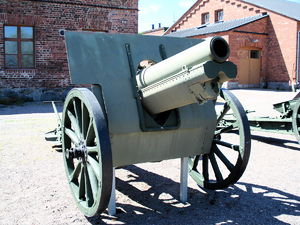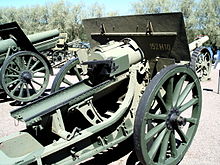
122 mm corps gun M1931/37 (A-19) was a Soviet field gun developed in late 1930s by combining the barrel of the 122 mm gun M1931 (A-19) and the carriage of the 152 mm howitzer-gun M1937 (ML-20). The gun was in production from 1939 until 1946. It saw action in World War II and remained in service for a long time after the end of the war. Vehicle-mounted variants of the gun were fitted to the IS-2 and IS-3 tanks of the Iosif Stalin series of tanks and the ISU-122 self-propelled gun.

The 152 mm howitzer-gun M1937 (ML-20), is a Soviet heavy gun-howitzer. The gun was developed by the design bureau of the plant no 172, headed by F. F. Petrov, as a deep upgrade of the 152-mm gun M1910/34, in turn based on the 152-mm siege gun M1910, a pre-World War I design by Schneider. It was in production from 1937 to 1946. The ML-20 saw action in World War II, mainly as a corps / army level artillery piece of the Soviet Army. Captured guns were employed by Wehrmacht and the Finnish Army. Post World War II, the ML-20 saw combat in numerous conflicts during the mid to late twentieth century.

The D-1 howitzer M1943 is a Soviet World War II-era 152.4 mm howitzer. The gun was developed by the design bureau headed by F. F. Petrov in 1942 and 1943, based on the carriage of the 122 mm howitzer M1938 (M-30) and using the barrel of the 152 mm howitzer M1938 (M-10). The powerful and mobile D-1, with its wide range of ammunition, significantly increased the firepower and breakthrough abilities of Red Army tank and motor rifle formations. Several hundred D-1s were manufactured before the end of World War II.

The 122 mm howitzer M1938 (M-30) is a Soviet 121.92 mm (4.8 inch) howitzer. The weapon was developed by the design bureau of Motovilikha Plants, headed by F. F. Petrov, in the late 1930s, and was in production from 1939 to 1955. The M-30 saw action in World War II, mainly as a divisional artillery piece of the Red Army (RKKA). Captured guns were also employed later in the conflict by the German Wehrmacht and the Finnish Army. Post World War II the M-30 saw combat in numerous conflicts of the mid- to late twentieth century in service of other countries' armies, notably in the Middle East.

The 76-mm divisional gun M1939 was a 76.2 mm cannon produced in the Soviet Union. It was adopted for Red Army service in 1939 and used extensively in World War II. The gun was designated as "divisional" - issued to batteries under the direct control of division headquarters. The F-22 USV was an intermediate model, coming between the F-22, which had limited anti-aircraft capability, and the simpler and cheaper ZiS-3, which eventually replaced it in production and service.

The 76-mm divisional gun M1936 (F-22) was a Soviet divisional semi-universal gun, adopted for Red Army service in 1936. This gun was used in conflicts between the USSR and Japan on the Far East, in the Winter War and in World War II. Many F-22s were captured by the Wehrmacht, modernized by the Germans and used against Soviet forces.

152-mm howitzer M1938 (M-10) was a Soviet 152.4 mm howitzer of World War II era. It was developed in 1937–1938 at the Motovilikha Mechanical Plant by a team headed by F. F. Petrov, and produced until 1941. It saw combat with the Red Army until the end of World War II and remained in service until the 1950s. Captured pieces were used by Wehrmacht and the Finnish Army. The latter kept the M-10 in service until 2000.

76 mm divisional gun M1902/30 was a Soviet modernized version of the Russian World War I 76 mm divisional gun M1902, employed in the early stages of Operation Barbarossa.

122 mm howitzer M1910/30 was a Soviet 121.92 mm (4.8 inch) howitzer, a modernization of World War I era 122 mm howitzer M1910. It was the most numerous divisional howitzer of the RKKA at the outbreak of Great Patriotic War and remained in service throughout the war.

122 mm howitzer M1909/37 was a Soviet 121.92 mm (4.8 inch) howitzer, a modernization of World War I era 122 mm howitzer M1909. The gun saw combat in the German-Soviet War.

152 mm howitzer M1909/30 was a Soviet 152.4 mm howitzer, a modernization of the 152 mm howitzer M1909, initially designed by Schneider. It was the most numerous 152 mm howitzer employed by Red Army in World War II.
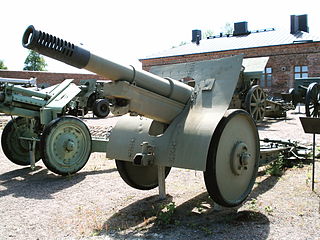
152-mm gun model 1910/30 was a Soviet howitzer, a modernization of World War I era 152 mm siege gun M1910. The gun was briefly used by Red Army in the Eastern Front of World War II.
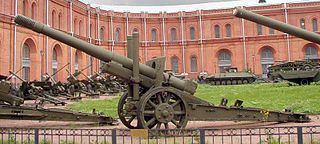
152-mm gun model 1910/34 was a Soviet 152.4 mm (6 inch) heavy gun, a modernization of the 152-mm gun M1910/30, which in turn was based on 152-mm siege gun M1910.
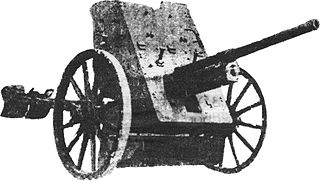
37 mm anti-tank gun model 1930 (1-K) was a Soviet light anti-tank gun used in the first stage of the German-Soviet War.

152 mm mortar M1931 (NM) was a 152.4 mm (6 inch) artillery piece originally developed by the German arms manufacturer Rheinmetall. The gun was produced in limited numbers in the Soviet Union and saw action with the Soviet Army in World War II. A modified version of the design was also adopted in Germany, as 15 cm sIG 33.

152 mm gun M1935 (Br-2) was a Soviet 152.4 mm heavy gun, produced in limited numbers by the Barrikady Plant in Stalingrad in the late 1930s. The most unusual feature of the gun was its tracked carriage, shared by a number of Soviet heavy artillery systems of the interwar period. Despite a number of drawbacks, most notably limited mobility and short service life of the barrel, the weapon was employed throughout the German-Soviet War; an upgraded variant with wheeled carriage, Br-2M, remained in service at least until the 1970s.
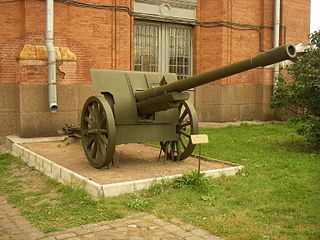
107 mm gun M1910/30 was a Soviet 106.7 mm field gun.

The 107 mm divisional gun M1940 (M-60) was a Soviet artillery piece, developed in the late 1930s in order to provide Soviet divisional artillery with a powerful field and anti-tank gun. The weapon entered production in 1940, but soon after the outbreak of the German-Soviet War, production ceased; only a limited number of pieces were built. These guns saw service in the Red Army during the war.

122 mm corps gun M1931 (A-19) was a Soviet field gun, developed in the late 1920s and early 1930s. In 1939 the gun was replaced in production by an improved variant, M1931/37. The piece saw action in World War II with the Red Army. Captured guns were employed by Wehrmacht and the Finnish Army.

The 120 mm Armata wz. 78/09/31 and 120 mm Armata wz. 78/10/31 were field guns produced and used by Poland during World War II and Finland during the Continuation War.
